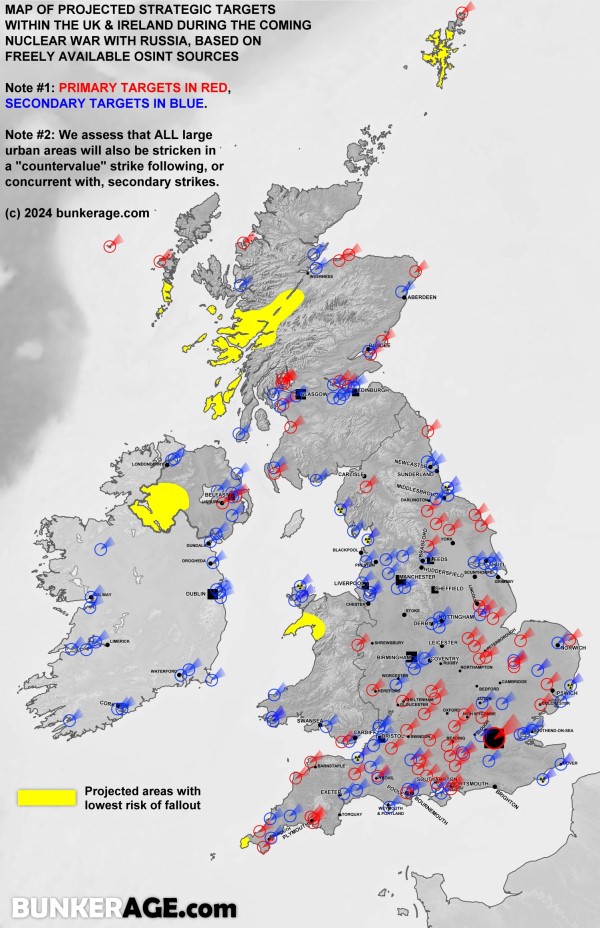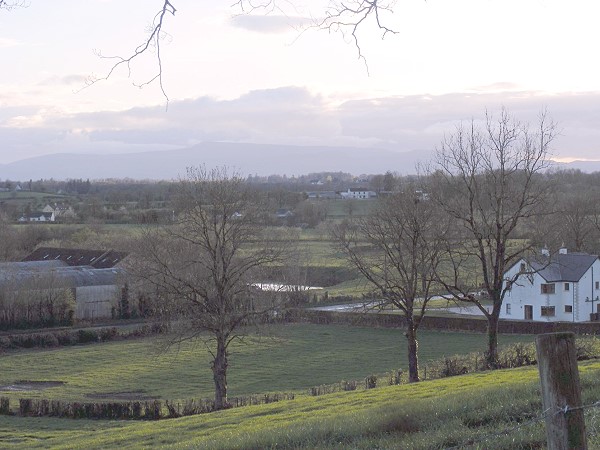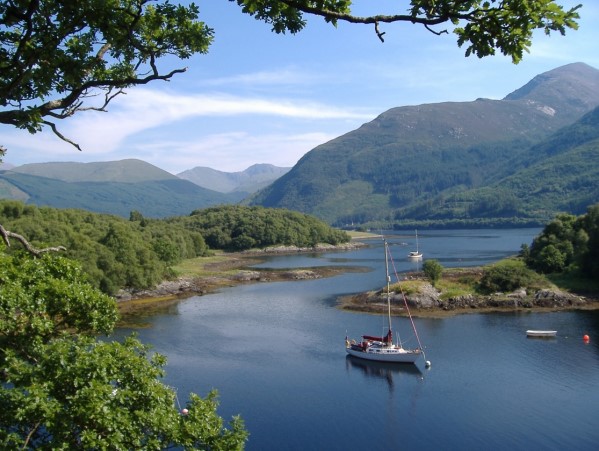Why is the UK Exceptionally Vulnerable in a Nuclear War?
The UK is a relatively small country in terms of its territorial extent, yet is packed with many military and industrial installations that make it a “target rich environment”
under nuclear war considerations.
Coupled with that is the extraordinarily high population density of much of England and Scotland’s Central Belt, placing the majority of the country’s population either
in the firing line, close to it, or radioactively downwind of it.
This means that even a counterforce strike on the UK (i.e. nuclear weapons directed against military
and command-and-control targets) would be devastating to the country’s civilian population.
But if Russia were to add to that a countervalue barrage against the cities, the loss of life would be
incomprehensibly vast, since the UK as a whole has an urban population
(as of 2022) of 84% and climbing.
Further, given that the UK has, unlike the more prudent Swedes, Finn and Swiss, no civil defence bunkering for its people whatsoever, the vulnerability of the British
people to nuclear attack is a national scandal on a colossal scale (and we presume it is due to politicians not wishing to divert funds from worthless spending on
foreign
aid to China (yes, China), India, Pakistan, etc.).
Accordingly, by way of an educated guess, we would project a best case loss of life in the coming nuclear war with Russia to be around 70% and a worst case of around 80%
(so it would not be instant death for everyone, and neither would it mean a slow lingering death for the survivors - see our blog article,
5 Popular Nuclear War Myths).
Either way, that would set the UK’s population back to
early 1800s levels,
or, put another way, it would undo two centuries of population expansion.
That would not present a truly existential razing to the ground of the UK as a nation, but it would take a long time before it could get back on its feet and
there might be decades of a more agrarian lifestyle for the survivors.
The key takeaways from this gloomy survey are:
- Projected loss of life: 70% (best case) to 80% (worst case) of the UK’s population, over 84% of which is urbanised, although note that 1978’s Scrum Half war game projected a mere 9% long-term survivors, but that was based on higher yields and an absolute worst case model.
- The coming war with Russia will be catastrophic to the western nations, particularly to their urban populations, and especially in those countries (such as the UK) that have recklessly not made any bunkering provisions.
- There will be a barrage of nuclear hail due to the vast size of Russia’s nuclear arsenal.
- Primary targets would be military, governmental, command-and-control, communications.
- Secondary targets would be airports, ports, major bridges, power stations, refineries and industry.
- Tertiary targets would be the large urban areas, as well as medium-sized cities.
- Under normal Russian doctrine, primary (and possibly secondary) targets would be the sole focus, with the objective being to force terms upon their destruction.
- Under an extreme scenario, the normal doctrine would be scrapped and an all-out vindictive assault on the cities of the West would ensue; this is the scenario we have to prepare for because (a) even the best laid plans can spiral out of hand and (b) we fully expect Russia to miscalculate itself into a genuine existential crisis.

(Contains Ordnance Survey data © Crown copyright and database right 2012, CC BY-SA 3.0, via Wikimedia Commons)
Which Regions of the UK Constitute the Best Retreat Locales?
If you examine the map in our article, Projected Nuclear War Targets in the UK and Ireland,
or the less detailed greyscale version above, it seems at first glance that the best places to sit out a nuclear war would be the Welsh interior,
Scotland’s Southern Uplands, the Scottish Highlands, most of the Hebrides, Shetland, Orkney and western Northern Ireland.
However, that is only valid insofar as accounting for blast radii (which exceed scorch radii), but it overlooks the terrible danger of radioactive fallout.
And so we have to think of prevailing wind patterns and the track of air masses over the British Isles in trying to determine the best retreat locales.
And we also have to be sensible about bunkering; some imagine a hardened, underground bunker within a projected blast zone will constitute a realistic survival strategy,
but a broad spectrum approach is far, far wiser, entailing relocation away from blast zones and as far upwind as possible (in terms of prevailing wind direction) to minimise the impact of
ongoing radioactive iodine dispersal via fallout.
Obviously, therefore, as forensic an assessment of the likely target matrix in the UK is essential, hence we recommend (once again) that you review our mapping derived from open
source intelligence (OSINT) materials freely available on the web.
In the UK, the prevailing direction of the track of airmasses is generally either from the west blowing east, or more commonly, from the south west drifting towards the north east,
which enables us to formulate a basis for assessing which areas of the country are best suited for mitigating the risk of fallout.
Those regions are the following:
- South-western Northern Ireland, containing County Fermanagh and most of County Tyrone. It is potentially downwind of any strike on the
Ireland West Airport in
County Mayo (a projected secondary or even tertiary target), but still offers the lowest fallout risk and direct strike risk, by far, of any region of the UK, has abundant rainfall
(i.e. it is notoriously wet), but has a better growing season and better farming ground conditions than its Scottish counterparts described below. Northern ireland also has a
very higher rural-to-urban population ratio than the mainland UK, with
approximately 36% of its population living in the countryside.
To acquire a proper grasp of its retreat credentials, see our article,
Northern Ireland as a Retreat Locale?

Fermanagh mountains (in distance), marking the highest point on the UK's land border with the EU! - A large swathe of the western Highlands along with most of the southern half of the Hebrides. The best spots are the Isles of Islay and Jura,
Lochaber west of Fort William and South Uist, but all of that has to be tempered by (a) the risk of any of the sea lochs in the area being attacked if NATO submarines are
detected lurking in them and (b) the
relative proximity to the high value primary targets dotted around Faslane to the east / south east.

Highlands near Ballachulish, inside Scotland's best fallout avoidance area. - The area comprising the Llyn Peninsula plus around, and inland of, the remaining northern reaches of Cardigan Bay. One gets the impression that many of a preparedness mindset in England look to Wales as “good retreat country”, but they may be surprised to find that only a very small part of it has remotely good fallout minimisation prospects, and even at that, there abides a much higher fallout risk should Russia adopt a “take no chances” approach and flatten the ports on neutral Ireland’s south coast in an act of area denial designed to pre-empt potential NATO commandeering. This concern was, as far as we are aware, first flagged during the UK government’s “Scrum Half” nuclear war game in 1978, which envisaged Dublin receiving both an air burst and a ground burst.
- Shetland apart its far north (which has a primary target in the form of the Saxa Vord remote radar station. With no mountains and no tree cover, Shetland is a windswept, rocky, and generally unpleasant place (allegedly!) fit for not much more than some sheep farming and growing very little. That might, of course, make it ideal for some looking for a WW3 bunker location!
- The far south western tip of Cornwall (Penzance and its immediate hinterlands, but I would not extend to to St Ives as that is too close for comfort to the remote radar station at Portreath).
The Best Nuclear War Retreat Areas in the Republic of Ireland
As we have stated elsewhere in our articles, Russia regards neutrality as cynical tactic rather than a valid alignment and while it was happy to humour Finland’s and Sweden’s
erstwhile neutrality for decades, it was only because those countries acted as a buffer zone that kept NATO’s containment forces at arms’ length.
(Russia is extremely prickly about the topic of buffering; even within Russia itself, there are manned exclusion zones around its borders where traffic transiting from, say,
the Baltic states into Russia (or vice versa) may not stop absent a burst tyre or some other emergency.)
In the case of Ireland, NATO planners (again, going by the disclosures in
The Secret State (2010 edition) by Peter Hennessy) always assumed that
Russia would seek to deprive
NATO of the use of its ports and airports in the event of nuclear war, which makes all of Ireland’s deep water ports and its handful of long-runway international airports
viable secondary targets in a WW3 scenario.
Unfortunately for the Irish, every single city and each major coastal town has a port of some kind, meaning that even a counterforce strike situation would automatically
double as a countervalue hit on the nation, on a near nation-ending level... Only the rural communities would stand a reasonable chance of survival.
So what of rural Ireland as a retreat locale?
Certainly there are good areas in terms of fallout mitigation, but Ireland’s looming
“right-sizing”
rules and its “local needs” requirements might make it hard for
outsiders to relocate there and start bunkering down.
Then there is the issue of its combustive immigration problem that is causing a lot of societal disquiet and resentment.
Perhaps worst of all is Ireland’s infamous hate speech bill that has so many observers around the
world recoiling in disgust at what is proposed (basically a charter for
persecuting anyone of a conservative outlook).
Concluding Thoughts
The above list of optimal retreat areas in the UK, of course, refers to the most favoured spots in terms of prevailing wind factored with predicted primary and secondary targets.
It does not, however, exclude other parts of the UK from being survivable.
On the contrary, most areas well away from the blast zones of primary and secondary targets would be survivable as long as (a) appropriate fallout sheltering is in place and
(b) the bunkering occurs in rural or semi-rural settings to minimise the risk of discovery before or during a nuclear attack.
(But do note that the greater the proximity to a blast zone, the thicker the concrete on the bunkering has to be to mitigate the
gamma radiation).
Generally, the key point is that there are no perfect locations, and sometimes only “less bad” options among a suite of far-from-ideal locales.
Nuclear war with Russia, when it comes later this decade, is going to rock the whole world and those who, for example, think migrating to New Zealand (which is in China’s
firing line) or hiding out in Latin America could be a panacea, are sure to find themselves adversely affected and disappointed to some degree or other.
Likewise, those who think the government has their back in this country are sure to be sorely disappointed.
Unlike the situation in Sweden, Finland, Switzerland and now Germany as well, the British government seems to want you to be either denialist or fatalist about nuclear war
preparedness, presumably so that no public calls for bunkering bubble up on time for them to do anything proactive about it.
But more importantly, the time to act is now, be in no doubt about that, because restrictions on commerce are coming within the next 12-24 months and people like us will no
longer be able to help, so if you are thinking of availing of our services, you should do so while you still can.

